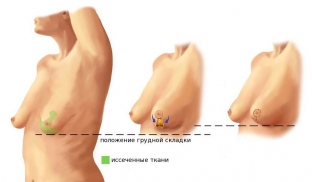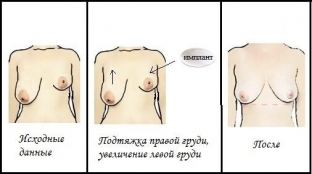Breast asymmetry belongs to the category of those aesthetic defects that can cause serious psychological problems for the patient. As you know, the right and left halves of the human body are not mirror images of each other, and therefore one breast of a woman will almost always be somewhat different from the other. Breast asymmetry – this is a pronounced difference in the shape, size and position of the breast. Surgery for breast asymmetry helps to effectively eliminate the defect, saving the patient from such imperfection. Read about the features of such an operation on estet-portal.com in this article.
Peculiarities of surgery for breast asymmetry
A slight difference between the shape and volume of the right and left mammary glands is observed in more than 80% of women, but, often, visually it is quite difficult to determine.
Breast asymmetry can be spoken of when the differences exceed 1 size, and the defect cannot be corrected even with the help of properly selected underwear.
For asymmetric breasts, surgery is the right solution, and many specialists perform such surgeries effectively. A significant deviation from the norm provokes a decrease in self-esteem in a woman, and becomes a cause of psychological discomfort, therefore breast asymmetry – this is a problem that needs an adequate solution.
Surgery for breast asymmetry:
- causes of breast asymmetry: why one gland is larger than the other;
- types of breast asymmetry: surgery will help with any of them;
- surgical options for breast asymmetry.
Causes of breast asymmetry: why one gland is larger than the other
Breast asymmetry – this is an aesthetic defect that can be congenital or acquired. Congenital asymmetry is a genetically determined feature of the body, and can be expressed as defects in the form of a complete absence of one gland, unilateral hypo- or hypermastia. The cause of acquired asymmetry of the breast can be mechanical damage to the gland, as a result of which the glandular tissue degenerates into adipose or fibrous, endocrine disorders, surgeries associated with the inflammatory process, as well as mastopathy or oncopathology. If before the age of 20 the correction of breast asymmetry did not occur independently – the patient may be indicated for surgery.
Types of breast asymmetries: surgery will help with any of them
Breast asymmetry is classified primarily according to the geometric shape of the breast. This, in the first place, affects the option of surgical correction of the defect. There are the following types of breast asymmetry:
- underdevelopment of one gland with normal size of the other;
- underdevelopment of both glands to varying degrees;
- underdevelopment of one gland with an increase in the other;
- enlargement and ptosis of one gland with a normal size of the other;
- bilateral enlargement of both glands with asymmetry;
- ptosis of one or both mammary glands to varying degrees;
- tubularity of the structure of one or both glands with a simultaneous increase or decrease in one of them;
- Asymmetry of areolas and nipples;
- Poland syndrome – underdevelopment of muscles, bones and mammary gland of one half of the chest.
Regardless of which variant of breast asymmetry the patient has, surgery can effectively solve this problem.

Surgical options for breast asymmetry
There are several options for correcting breast asymmetry effectively. Specialists individually select the option of surgical restoration of breast symmetry, depending on what type of asymmetry is observed in the patient, and what result of the operation she expects. There are the following options for operations with breast asymmetry:
- unilateral or bilateral breast prosthetics with implants;
- enlargement of one breast with the help of an implant and simultaneous reduction plastic surgery of the second one;
- reduction of one breast;
- in varying degrees; bilateral prosthetics with one-dimensional implants in combination with a breast lift in varying degrees;
- endoprosthesis replacement of one gland with simultaneous mastopexy of both;
- correction of the shape and size of areolas and nipples.

Plastic surgeons approach each problem very carefully and delicately and help to solve it as efficiently as possible.






Add a comment